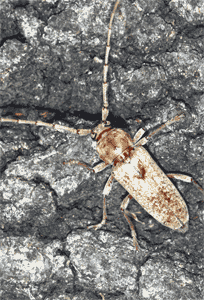
One of the often overlooked side effects of wind damage to trees is the subsequent attack of trees by wood boring beetles. Yet it is a relatively simple task to reduce the risk of wood boring insects infesting damaged or weakened trees.
Of first importance is proper dressing of the wound. Pest management professionals should leave all but the most modest jobs of this nature to the homeowner or the professional arborist; but knowing something about the process can be helpful in recognizing whether a proper treatment has been made to give the tree the best chance of survival.
A University of Tennessee publication by Wayne Clatterbuck offers the following advice for dressing broken low level branches:
- Smaller branches should be pruned back to the point where they join larger ones. Make the cut at a slant next to a bud that can produce new growth. Do not leave branch stubs as they encourage rot and decay.
- Large branches that are broken should be cut back to either the trunk or main limb. Do not cut the branch flush with the trunk. Instead, cut outside the collar at the base of the branch.
- When a damaged limb strips healthy bark from the tree, cut the ragged edges of torn bark with a sharp knife or chisel. Take care not to remove any more healthy bark and expose more live tissue than necessary. If possible, the wound left by the cut should be shaped like an elongated football with the pointed ends of the cut running vertically along the trunk or limb.
- Trees should not be "topped" during the repair process. Topping accelerates shoot growth and promotes branches that are weakly attached to stubs rather than anchored from within the limb. These branches are more likely to break in future storm events.
- Tree wound dressings (paint, tar and others) do not prevent decay, may interfere with rapid healing and in some cases can serve as food sources for harmful microorganisms.

If you carry a Turf and Ornamentals category license in Texas, this is an additional service you can provide to your customers with newly damaged trees. Products normally used include bifenthrin (Onyx®, Talstar®) and permethrin (Astro®). Applications should be made to and around obvious wound areas, as well as around the crotches and base of the tree. It is a good idea to provide a follow-up treatment 6 to 8 weeks after the initial application.
For more information about wood boring beetles see Wood Boring Insects of Trees and Shrubs at the Texas AgriLife Extension bookstore.
No comments:
Post a Comment